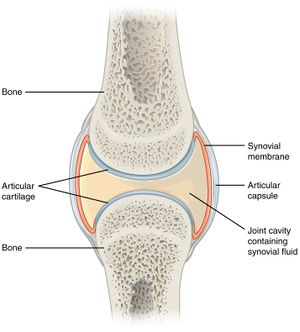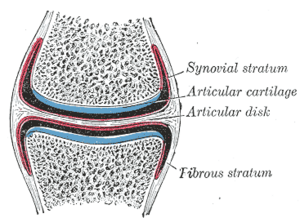Synovium & Synovial Fluid: Difference between revisions
No edit summary |
No edit summary |
||
| Line 24: | Line 24: | ||
Subintima layer | Subintima layer | ||
* Thicker layer of loose connective tissue which contains fewer cells | * Thicker layer of loose connective tissue which contains fewer cells | ||
* Composed of fatty, fibrous or loose areolar tissue, allowing movement.<ref>Radiopedia Synovium Available from:https://radiopaedia.org/articles/synovium?lang=gb (accessed 18.6.2021)</ref>. | |||
== | == Synovial Fluid == | ||
This fluid is generated from an ultrafiltrate of blood plasma which is regulated by synovium. The purpose of this fluid is to lubricate the cartilage of the bone joint and provide nourishment through diffusion. It is made from a ultrafiltrate of blood plasma and is regulated by the synovium. eg healthy knee contains ~2mL of synovial fluid. | |||
Consists of: | |||
* Hyaluronin (enzyme critical for its synthesis) | |||
* Lubricin (a key lubricating glycoprotein, reduces coefficient of friction within the joint) | |||
* Proteinase | |||
* Collagenases | |||
* Prostaglandins | |||
Biomechanics: | |||
* Synovial fluid exhibits non-Newtonian flow characteristics (Viscosity coefficient is not a constant; Fluid is not linearly viscous; Viscosity increases as the shear rate decreases).<ref name=":0" /> | |||
== Resources == | == Resources == | ||
Revision as of 08:07, 18 June 2021
This article or area is currently under construction and may only be partially complete. Please come back soon to see the finished work! (18/06/2021)
Original Editor - Lucinda hampton
Top Contributors - Lucinda hampton, Kim Jackson and Kirenga Bamurange Liliane
Introduction[edit | edit source]
Synovium (also called the synovial membrane) is a specialized connective soft-tissue membrane that lines the inner surface of synovial joint capsules. Together with bone, articular cartilage, tendon, ligament, and fibrous capsule, it is an important component of the tissues that form an integrated joint. As such, it not only has its own specific functions but also interacts with other tissues in the joint both structurally and functionally[1].
Synovial fluid lubricates articular cartilage and provides nourishment through diffusion. It made from a ultrafiltrate of blood plasma, produced and regulated by the synovium.[2]
Anatomy[edit | edit source]
The synovial membrane consists of an
Intimal layer:
- Well innervated and vascularised containing different types of cells including fibroblasts, macrophages, adipocytes, nerve fibres, vascular endothelial cells as well as lymphocytes.
- Features two types of synoviocytes: type A - derived from macrophages; non-fixed cells with antigen presenting ability located in superficial layer; important in phagocytosis and fibroblastic. Type B cells - fibroblast like cells; rich rough endoplasmic reticulum and dendritic processes that reach out to the joint surface; located at various depths, frequently in deeper layer; produce synovial fluid[2].
Subintima layer
- Thicker layer of loose connective tissue which contains fewer cells
- Composed of fatty, fibrous or loose areolar tissue, allowing movement.[3].
Synovial Fluid[edit | edit source]
This fluid is generated from an ultrafiltrate of blood plasma which is regulated by synovium. The purpose of this fluid is to lubricate the cartilage of the bone joint and provide nourishment through diffusion. It is made from a ultrafiltrate of blood plasma and is regulated by the synovium. eg healthy knee contains ~2mL of synovial fluid.
Consists of:
- Hyaluronin (enzyme critical for its synthesis)
- Lubricin (a key lubricating glycoprotein, reduces coefficient of friction within the joint)
- Proteinase
- Collagenases
- Prostaglandins
Biomechanics:
- Synovial fluid exhibits non-Newtonian flow characteristics (Viscosity coefficient is not a constant; Fluid is not linearly viscous; Viscosity increases as the shear rate decreases).[2]
Resources[edit | edit source]
- bulleted list
- x
or
- numbered list
- x
References[edit | edit source]
- ↑ Musculoskeletal Key Synovium Available: https://musculoskeletalkey.com/synovium-and-joint-biology/(accessed 18.6.2021)
- ↑ 2.0 2.1 2.2 Orthobullets Synovium Available from:https://www.orthobullets.com/basic-science/9018/synovium-and-synovial-fluid (accessed 18.6.2021)
- ↑ Radiopedia Synovium Available from:https://radiopaedia.org/articles/synovium?lang=gb (accessed 18.6.2021)








